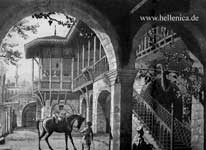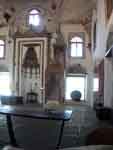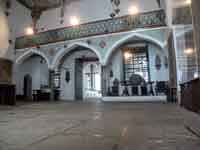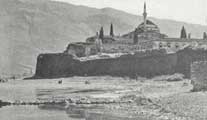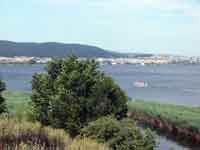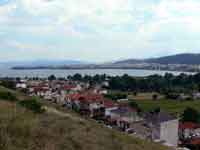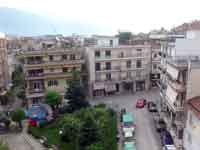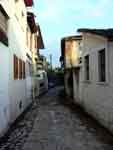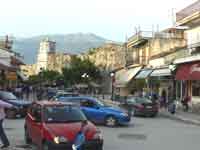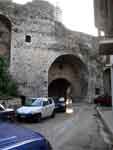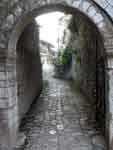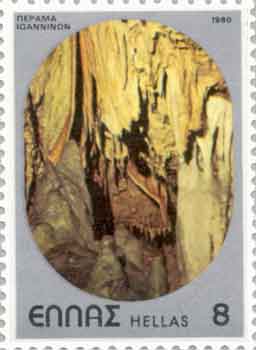.


Administrative Region : Epirus
Regional unit : Ioannina
Ioannina (Greek: Ιωάννινα, Greek pronunciation: [ioˈanina]), often called Jannena (Γιάννενα, Greek pronunciation: [ˈʝanena]) within Greece, is the largest city of Epirus, north-western Greece, with a population of 70,203 (in 2001). It lies at an elevation of approximately 500 meters above sea level, on the western shore of lake Pamvotis (Παμβώτις). It is located within the Ioannina municipality, and is the capital of Ioannina peripheral unit and the Periphery of Epirus. Ioannina is located 450 km northwest of Athens, 290 km southwest of Thessaloniki and 80 km east of the port of Igoumenitsa in the Ionian Sea.
Founded by the Byzantine Emperor Justinian in the 6th century AD, Ioannina flourished following the Fourth Crusade, when many wealthy Byzantine families fled there in the early 13th century following the sack of Constantinople. It was the capital of the Despotate of Epirus from 1358 to 1416, before surrendering to the Ottomans in 1430. Between 1430 and 1868 the city was the administrative center of the Pashalik of Yanina. In the period between the 16th and 19th centuries, the city was a major center of the modern Greek Enlightenment.[1][2][3][4] Ioannina joined Greece in 1913 following the Balkan Wars.
The city has both a General and a University Hospital,[5] and is the seat of the University of Ioannina (situated 5 km south of the city, with 17 departments[6] and 20,000 students) as well as several departments of the Τechnological Educational Institute of Epirus,[7] the headquarters of which are located in Arta.
The city's emblem consists of the portrait of the Byzantine Emperor Justinian crowned by a stylized depiction of the nearby ancient theater of Dodona.
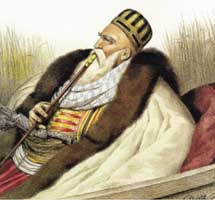
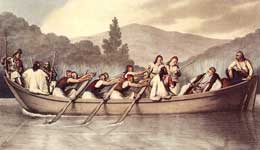
Name
The city's formal name, Ioannina, means "Town of John" in Greek. There are two name forms in Greek, Ioannina being the formal and historical name, while the colloquial and more commonly used Jannena or Jannina (Greek: Γιάννενα) represents the vernacular tradition of Demotic Greek. The demotic form also corresponds to those in the neighbouring languages (e.g. Albanian: Janinë, Aromanian: Ianina, Turkish: Yanya).

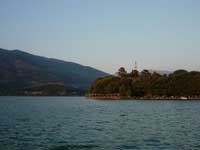
Ioannina from Space with the Lake Pamvotis, Lake
History
Antiquity
The ancient theatre of Dodona, near Ioannina.
The first indications of human existence in the prefecture of Ioannina are dated back to the Paleolithic period (38,000 years ago). This is testified by the stone tools that were found in the cavern of Kastritsa. The first recorded inhabitants of the area were the Epirote Greek tribe of the Molossians.
Byzantine period
The main entrance to the medieval fortress of the city.
It is unknown when exactly the city was founded, but an unnamed new, "well-fortified" city, recorded by the historian Procopius (De Aedificiis, IV.1.39–42) as having been built by the Byzantine emperor Justinian I (r. 527–565) for the inhabitants of ancient Euroia, is usually identified with Ioannina.[8]
However, it was not until 879 AD that the name Ioannina was used for the first time in the Acts of the Fourth Council of Constantinople in 879, which refer to one Zacharias, Bishop of Ioannina. During the time of Tsar Samuil of Bulgaria, the town was part of the Bulgarian Empire. The name Ioannina was also mentioned as an Episcopal See, under the self-governing (Autocephalous) Bulgarian Archbishopric of Ohrid in 1020 in an imperial document by Basil II (r. 976–1025).
The city was conquered in 1082 by the Normans under the leadership of Bohemond of Taranto, who repaired the existing city walls in order to repel the offensive of emperor Alexios I Komnenos (r. 1081–1118). Alexios I nonetheless recovered the city in 1108.
Despotate of Epirus (1204–1430)
See also: Despotate of Epirus
The Despotate of Epirus (in green) from 1230 to 1251.
The "Rule (Orismos) of Sinan Pasa" (9 Oct. 1430), written in Greek, which granted to the citizens a series of privileges.
In the 13th century, the creation of the Despotate of Epirus favored Ioannina, which became its second most important city after its capital, Arta, and the capital of a thema of Ioannina.[8] The founder of the Despotate, Michael I Komnenos Doukas settled refugee noble Byzantine families, such as the Philanthropenoi, Strategopouloi, Dragovitsoi, Zervoi, etc., who fled Constantinople after the fall of the city to the Fourth Crusade.[CN] These refugee families, together with the local nobility, took over the government of Ioannina in 1318 and broke away from Arta. In the same year, Ioannina became tributary to the Byzantine emperor Andronikos II Palaiologos (r. 1282–1328). The city was elevated to a metropolitan bishopric, and in 1319 Andronikos II issued a chrysobull conceding wide-ranging autonomy and various privileges and exemptions on its inhabitants.[8]
In 1337–1340, Andronikos III Palaiologos (r. 1328–1341), aided by John Kantakouzenos, dissolved the Despotate of Epirus and Ioannina became once again part of the Byzantine Empire. A few years later however it fell to the Serbs, who had, by then, expanded their state over much of Byzantine and Bulgarian territory to form the Serbian Empire. The city's privileges were also honored by the Serbs, and as a result Ioannina rose to economic and cultural prominence over the next century. The city flourished, becoming an important financial and cultural center. During the Byzantine times it was referred to as the "metropolis of knowledge".
The city was the capital of the restored Despotate of Epirus from 1358 to 1416. In 1366/67 the Serb Thomas II Preljubović became the new overlord of Ioannina, under whose rule the city stood against Albanian attacks. After Preljubović's death in 1384, the city surrendered to Esau de' Buondelmonti (1385–1411) and Carlo I Tocco (1411–1430).[9]
Early Ottoman period (1430–1647)
View of the Municipal Ethnographic Museum of Ioannina, Aslan Pasha Mosque.
The death of Tocco in 1430 signaled the submission of Ioannina to the Ottoman Turks who granted several privileges to the town in exchange for its surrender. These were known as the Rule of Sinan Pasha, from the name of Kara Sinan Pasha, who signed the treaty. Iosnnina became a seat of the Ottoman Sanjak of Ioannina.
In 1611 the city suffered a serious setback as a result of a peasant revolt led by Dionysius the Philosopher (aka Skylosophos), Bishop of Larisa. The Greek inhabitants of the city were unaware of the intent of the fighting as previous successes of Dionysios had depended on the element of surprise. Much confusion ensued as Turks and Christians ended up indiscriminately fighting friend and foe alike. The revolt ended in the abolition of all privileges granted to the Christian inhabitants, who were driven away from the castle area and had to settle around it. From then onwards, Turks and Jews were to be established in the castle area. The School of Despoton at the Church of Taxiarches, that had been operating since 1204 was closed. Aslan Pasha also destroyed the monastery of St John the Baptist within the city walls, killed the monks and in 1618 erected in its place a mosque, Aslan Camii, today a museum.[10]
Center of Greek Enlightenment (1647–1830)
A depiction of Zosimaia School (19th century).
Kaplaneios School.
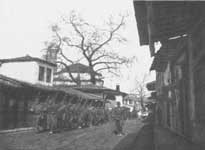
22 .2.1913, Liberation of Ioannina, Greek Troops in the city
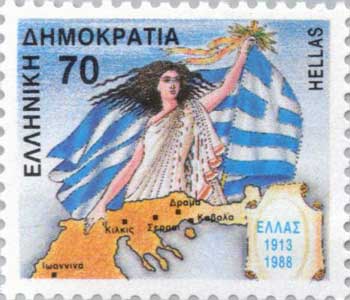
1913 liberation of Ioannina, Kilkis, Serres, Drama, Kavala
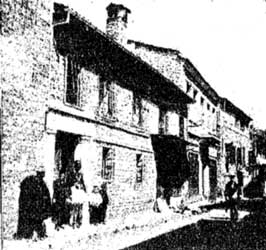
The House of Lord Byron during his visit
Despite that blow, the city managed to recover. Its inhabitants continued their commercial and handicraft activities which allowed them to trade with important European commercial centers, such as Venice and Livorno, where merchants from Ioannina established commercial and banking houses. The first three Greek owned printing presses that were operating in Venice and published thousands of books for the Ottoman ruled Greek people were established by members of the Ioannite diaspora: Nikolaos Glykys (1670), Nikolaos Sarros (1687) and Dimitrios Theodosiou (1755).[11] Ioannina was the centre through which the books printed on these presses were channelled into Greece.[12] These were significant historical, theological as well as scientific works, including an algebra book funded by the Zosimades family of Ioannitan benefactors, books for use in the schools of Ioannina such as the Arithmetica of Balanos Vasilopoulos, as well as medical books. At the same time these merchants and entrepreneurs maintained close economic and intellectual relations with their birthplace and founded charity and education establishments. These merchants were to be major national benefactors.
In the 17th century Ioannina was a thriving city with respect to population and commercial activity as both French and Turkish travelers Jacques Spon and Evliya Çelebi, respectively, attest. Evliya Çelebi visited the city in 1670 and mentioned the presence of 1,900 shops and workshops and 4,000 houses. The great economic prosperity of the city was followed by remarkable cultural activity. During the 17th and 18th centuries, many important schools were established.[13] The Epiphaniou was founded in 1647 by a Greek merchant in Venice, Epiphaneios Igoumenos.[14] The School of Gouma or Gioumeios was founded in 1676 by a benefaction from another wealthy Ioannitan Greek from Venice, Emmanuel Goumas. It was renamed to Balaneios by its Rector, Balanos Vasilopoulos in 1725. Here worked several notable personalities of the Greek Enlightenment, such as Bessarion Makris, the priests Georgios Sougdouris (1685/7–1725) and Anastasios Papavasileiou (1715-?), monk Methodios Anthrakites, his student Ioannis Vilaras and Kosmas Balanos. The Balaneios taught Philosophy, Theology and Mathematics. It suffered financially from the capture of Venice by the French and finally stopped in 1820. The school's library that hosted several manuscripts and epigramms was also burned the same year due to Ali Pasha's activities.[15] Another school founded by a benefaction by merchants of the Maroutsis family, which were also active Venice. The Maroutsaia School opened in 1742 and its first director Eugenios Voulgaris championed the study of the Physical Sciences (Physics and Chemistry) as well as philosophy and Greek. The Maroutsaia also suffered by the fall of Venice and closed in 1797 to be reopened as the Kaplaneios thanks to a benefaction from an Ioannitan living in Russia, Zois Kaplanis. Its schoolmaster, Athanasios Psalidas had been a student of Methodios Anthrakites and had also studied in Vienna and in Russia. Psalidas established an important library of thousands of volumes in several languages and laboratories for the study of experimental physics and chemistry that caused the interest and suspicion of Ali Pasha. The Kaplaneios was burned down as most of the rest of the city after the entry of the Sultan’s armies in 1820. These schools took over the long tradition of the Byzantine era, giving a significant boost for the Greek Enlightenment. Neophytos Doukas a famous Epirote scholar wrote, with a little exaggeration[16]:
During the 18th century, every author of the Greek world, was either from Ioannina or was a graduate of one of the city's schools.
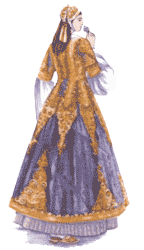
In 1789 the city became the center of the territory ruled by Ali Pasha, an area that included the entire northwestern Greece, Thessaly and parts of Euboea and the Peloponnese. The Ottoman-Albanian lord Ali Pasha was one of the most influential personalities of the region in the 18th and 19th century. Born in Tepelenë, he maintained diplomatic relations with the most important European leaders of the time and his court became a point of attraction for many of those restless minds who would become major figures of the Greek Revolution (Georgios Karaiskakis, Odysseas Androutsos, Markos Botsaris and others). Although during this time Ali Pasha committed a number of atrocities against the Greek population of Ioannina, culminating with the sewing up of local women in sacks and drowning them in the nearby lake,[17] this period of his rule coincides with the greatest ever economic and intellectual era of the city. As a couplet has it "The city was first in arms, money and letters". The efforts of Ali Pasha to break away from the Sublime Porte alarmed the Ottoman government, and in 1820 (the year before the Greek War of Independence began) he was declared guilty of treason and Ioannina was besieged by Turkish troops. Ali Pasha was assassinated in 1822 in the monastery of St Panteleimon on the island of the lake, where he took refuge while waiting to be pardoned by Sultan Mahmud II.
Period 1830–1943
Naval gun of 1820 from Ioannina's fortress (used during the Greek War of Independence)
Greek lithography showing the surrender of Ioannina by Essat Pasha to the Greek Crown Prince Constantine I during the First Balkan War
The deportation of the Jews of Ioannina on 25 March 1944.
The Zosimaia was the first significant educational foundation after the outbreak Greek War of Independence (1828). It was financed by a benefaction from the Zosimas brothers and began operating in 1828 and fully probably from 1833.[18] It was a School of Liberal Arts (Greek, Philosophy and Foreign Languages). The Zosimaia was badly damaged in an air raid by Italian planes in 1940 and was rebuilt on a new more spacious location with donations from Ioannitans after 1955.[19] The mansion of Angeliki Papazoglou became a school for girls called Papazogleios as an endowment following her death and operated until 1905. Today it is a public school. In 1869, a great part of Ioannina was destroyed by fire. Nonetheless, the marketplace was soon reconstructed according to the plans of the German architect Holz and thanks to the personal interest of Ahmet Rashim Pasha, the local governor. The communities of people from Ioannina living abroad were active in financing the construction of most of the city's churches (the Cathedral, St. Nicholas of the Agora, St. Marina, Archimandrio etc.), schools and other elegant buildings of charitable establishments. The first bank of the Ottoman Empire, the Ottoman Bank, opened its first branch in Greece in Ioannina which shows the power of the city in world trade in the 19th century. During the spring of 1877 the Albanian leaders organized a congress in the city regarding the decisions of the Constantinople Conference and sent a memorandum to the Ottoman government demanding among others the establishment of Albanian language schools.[20][21] In May 1877 the Albanians of the city led by Abdyl Frashëri formed the Albanian Committee of Janina, an organization with the aim of defending Albanian rights.[22] On the other hand, the Greek population of Ioannina region authorized a committee in order to present to the European governments their wish for union with Greece and Dimitrios Chasiotis, a notable member of this committee, published a memorandum in Paris in 1879.[23]
Ioannina was incorporated into the Greek state on 21 February 1913 after the Battle of Bizani in the Balkan Wars. After the Asia Minor Catastrophe (1922) and the subsequent population exchange, the Turkish element left, and the city received Greek refugees from Asia Minor.
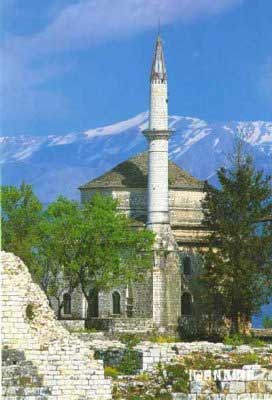
Jewish community
According to oral folklore Jewish communities inhabited the site of the modern city as early as 70 AD. According to Greek scholar P. Aravantinos a synagogue destroyed in the 18th century bore an inscription, which dated its foundation in the late 9th century AD.[24] There was a Romaniote Jewish community living in Ioannina before World War II. The Nazis deported the majority of them (1,860) to concentration camps during the final months of German occupation in 1944. Almost all of the people deported were murdered on or shortly after 11 April 1944, when the train carrying them reached Auschwitz-Birkenau. Today only around 50 are left.[25][26]
Climate
Ioannina has a Mediterranean climate tempered by its inland location and elevation. Summers are typically hot and dry, while winters are wet and colder than on the coast. Ioannina is the wettest city in Greece. The absolute maximum temperature ever recorded was 42.4°C, while the absolute minimum ever recorded was −13°C.[27]
Climate data for Ioannina
| Climate data for Ioannina | |||||||||||||
|---|---|---|---|---|---|---|---|---|---|---|---|---|---|
| Month | Jan | Feb | Mar | Apr | May | Jun | Jul | Aug | Sep | Oct | Nov | Dec | Year |
| Average high °C (°F) | 10.1 (50.2) |
11.5 (52.7) |
14.4 (57.9) |
17.1 (62.8) |
23.0 (73.4) |
27.6 (81.7) |
30.8 (87.4) |
30.9 (87.6) |
26.7 (80.1) |
21.2 (70.2) |
15.5 (59.9) |
11.1 (52.0) |
20.0 |
| Daily mean °C (°F) | 4.7 (40.5) |
6.1 (43.0) |
8.8 (47.8) |
12.4 (54.3) |
17.4 (63.3) |
21.9 (71.4) |
24.8 (76.6) |
24.3 (75.7) |
20.1 (68.2) |
14.9 (58.8) |
9.7 (49.5) |
5.9 (42.6) |
14.25 |
| Average low °C (°F) | 0.2 (32.4) |
1.0 (33.8) |
3.2 (37.8) |
5.9 (42.6) |
9.6 (49.3) |
12.8 (55.0) |
14.9 (58.8) |
15.0 (59.0) |
12.2 (54.0) |
8.5 (47.3) |
4.7 (40.5) |
1.8 (35.2) |
7.5 |
| Precipitation mm (inches) | 124.2 (4.89) |
111.6 (4.394) |
95.4 (3.756) |
78.0 (3.071) |
69.3 (2.728) |
43.5 (1.713) |
32.0 (1.26) |
31.2 (1.228) |
54.0 (2.126) |
99.5 (3.917) |
167.2 (6.583) |
174.9 (6.886) |
1,181 (46.5) |
| % humidity | 76.9 | 73.7 | 69.5 | 67.9 | 65.9 | 59.1 | 52.4 | 54.4 | 63.6 | 70.8 | 79.8 | 81.5 | 68.0 |
| Avg. precipitation days | 13.3 | 12.4 | 12.8 | 12.6 | 11.0 | 6.9 | 4.8 | 4.8 | 6.5 | 9.7 | 13.7 | 15.2 | 123.7 |
| Source: Greek National Weather Service [1] | |||||||||||||
Landmarks and sights
A street in Ioannina
View of Lake Pamvotis with its islet
Church of the Assumption, Pamvotis island
Clocktower of Ioannina
A street of the city Ioannina by night
Fethiye Mosque
Islet of Pamvotis lake: One of the most notable attractions of Ioannina is the islet on Lake Pamvotis. The island is referred to as "Nisaki" (Νησάκι, Greek for "little island", literally) by everyone, including its inhabitants. Passengers are ferried back and forth from the mainland to the island (about a 15-minute ride each way) on small motorboats which run on varying schedules, according to the season (about once every half hour, or more, in the spring and summer, much less frequently in the winter). Tourists can visit the monastery of Agios Panteleimon which has been converted into a museum containing information and paintings, as well as re-creations of Ali Pasha's lounging and living quarters. Ali Pasha spent the last days of his life in St Panteleimon, waiting for a pardon from the Sultan.
The Island Museum is not the only attraction on the island: there are many gift-shops, tavernas, churches and bakeries on the island's winding streets. Some of the people of Ioannina even choose to make the tiny island their yearlong home, with simple rowboats moored outside their homes, or in small marinas, in the event they need to get to Ioannina proper when the motorboats are not running. The island of Ioannina in Lake Pamvotis has six monasteries [10]: the monastery of St Nicholas (Ntiliou) or Strategopoulou from the 11th C, the Monastery of St Nicholas (Spanou) or Philanthropinon from 1292, St John the Baptist (1506 AD), Eleousis (1570 AD), St Panteleimon (17th C) and of the Transfiguration of Christ (1851 AD). The monasteries of Strategopoulou and Philanthropinon functioned also as colleges. In the latter taught Alexios Spanos, the monks Proklos and Comnenos and the Apsarades brothers, Theophanis and Nektarios.[10] The school continued its activities until 1758, when it was superseded by the newer collegial foundations within the city.
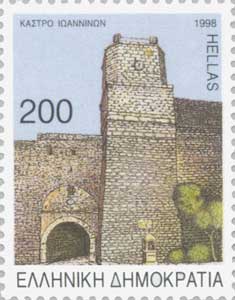 |
||
Ioannina has wealth of attractions and museums, highlighting that the traffic difficulties in the city and the spatial fragmentation of attractions, the visitor finds it difficult enough to visit them all. The most notable attractions are the following:
The National Archaeological Museum of Ioannina, Litharitsia Castle Square. Includes archaeological exhibits from 4 prefectures of Epirus.You can see here all the history of Epirus from prehistoric Time until 19th century.[28]
The Ioannina castle' It is in the center of the town, and was the heart of the Despotate of Epirus, and the Ottoman vilayet. The maze-like layout of the castle's streets (many of which lead to dead ends) were allegedly designed to confuse pirates of old who breached the castle walls: they would get lost within the fortress, and thus be captured before escaping with their bounty. The citadel bears the name Its Kale (Ιτς Καλέ, from Turkish Iç Kale, "inner castle").[28]
The Fethiye Mosque: It is located in Its Kale Fortress. The name means the conquest Mosque was built in 1430 on the ruins of a Byzantine church. Originally a wooden post in 1611 but was rebuilt stone. The final form was given by Ali Pasha in 1795.[28]
The Aslan Pasha Mosque: The Aslan Pasha Ottoman Mosque now houses the Municipal Ethnographic Museum and its three departments, Greek, Ottoman Muslim and Jewish.[28]
The Old Ottoman Library: The building is ruined. You can see it from outside.[28]
The House Hussein Matei (= Bishop House) (Hussein Matei House). The building is ruined. You can see it from outside.[28]
The Veli Pasha Ottoman Mosque.[28]
Historic Centre of Ioannina: You can see here small traditional shops and houses, and many souvenir shops.[28]
Stoa Loulis (= Arcade Loulis): In this commercial center existed for many years, the three religious nations in the city, Christians, Jews and Muslims. Initially the gallery operated an Inn and then became a commercial center.
The Byzantine Museum: Housed in a building rebuilt on the ruins of seraglios of Ali Pasha, which was completely destroyed by fire in 1870. The museum opened in 1995 in order to preserve the findings of the wider region of Epirus, chronologically covering the early Christian, Byzantine and post-Byzantine period. Also outside the museum from the report of collections, and a cultural center after hosts musical and theatrical events, periodic reports, etc. The collections include early Christian and Byzantine sculptures and exhibits Arta, ceramics, books, pictures and valuable collection of silverware. The summer season runs every Monday 12.00-19.00 hours and rest days 08.30-19.00. The museum is accessible to people with disabilities.[28]
The Museum of Fotis Rapakousis: Located in the complex of Aslan Mosque, in north-west of the fortress citadel of Ioannina. The City Knights, by mutual concession relationship between him and the collector, the collection of hosts on its premises, since 2000. This has included so the cultural resources and currently operates in parallel with the Municipal Folklore and Ethnographic Museum, housed in Aslan Mosque. The entire collection contains 6,000 objects, grouped in four categories: weapons with their accessories, jewelry from the 18th and 19th centuries, various, ceramics (Islamic art pottery of the Greek area, Tsanak Kale) Opening hours: 9.00 to 16.00.[28]
The Municipal Gallery of Ioannina (Dimotiki Pinakothiki): Housed since 2000 in Pyrsinela neoclassical building, built in 1890. Basil Pyrsinella who served as mayor of Ioannina, spent the entire movable and immovable property in 1958 in the municipality of Ioannina. In 1960 he created the first Regional Municipal Art Gallery in Greece, which first opened in the building until metestegasi Mela in today's housing. The works of the Gallery's collection are major stoys Modern, painters and sculptors, which was collected through purchases and donations from various collectors and artists. This includes about 500 works, paintings, drawings, prints, pictures and sculptures. Hours Monday to Friday 9:00 to 13:00 and 18:00 to 21:00. Weekends 10:00 to 13:00 and 18:00 to 21:00.[28]
Botanically, the region of Ioannina is dominated by robust, fragrant pine trees, many of which grow within the city itself, especially around the old castle, or fortress walls.
The Cathedral of St Athanasius was completed in 1933. It was built on the foundations of the previous Orthodox Cathedral which was destroyed in the fires of 1820. It is a three-aisled basilica. It has become a place of pilgrimage for the martyrdrom of St George of Ioannina, an orphaned youth hanged in public by the Turks in 1838 for proclaiming his Christian faith.
The churches of the Assumption of the Virgin at Perivleptos, St Nicholas of Kopanon and St Marina were rebuilt in the 1850s by funds from Nikolaos Zosimas and his brothers on the foundations of previous churches that perished in the great fire of 1820.
The Jewish Synagoge of Ioannina: During the Ottoman period, the Jewish community, both Sepharadi and Romaniote, experienced a flowering. The Jews of Ioannina were an active presence in the city's life until March 1944, when the German occupation troops arrested the entire population, 1,870 strong at the time, along with Jews from Preveza, Arta and Corfu, and deported them to the Auschwitz-Birkenau concentration camp, where most perished. Today the community compirises about 60 persons and the synagoge lies inside the Castle of Ioannina. Date 7th Century.[28]
Near Ioannina, Template:Convert/Km south of the city, lies the Pavlos Vrellis Greek History Museum, a museum with wax statues, like the Madame Tussaud Museum in London, England. Established on year 1995 this second Museum of Pavlos Vrellis (died 2010) is the result of the personal work of one man.[28]
Local products
Feta cheese with olives.
The region of Ioannina is well known for the production of feta cheese. The area is also famous for its spring water Zagori, which is sold over much of Greece.
Ioannina is famous throughout Greece for its silverwork, with a plethora of shops selling silver jewelry, bronzeware and decorative items (serving trays, recreations of shields and swords, etc.). The ornate style of the jewelry and artwork tends to reflect more Turkish sensibilities than Greek ones, likely due to the lengthy Turkish occupation of the area.
Hookahs are sold to tourists as novelty items and vary in size from small (3 inches in height) to quite large (4-5 ft (2 m). tall). The larger sized hookahs are often purchased by Greeks and tourists alike to be used in home decor.
Newspapers
Ipirotikos Agon is a locally published newspaper.
Municipality
The present municipality Ioannina was formed at the 2011 local government reform by the merger of the following 6 former municipalities, that became municipal units (constituent communities in brackets):[29]
Ioannina (Ioannina, Exochi, Marmara, Neochoropoulo, Stavraki)
Anatoli (Anatoli, Bafra, Neokaisareia)
Bizani (Ampeleia, Bizani, Asvestochori, Kontsika, Kosmira, Manoliasa, Pedini)
Ioannina Island (Greek: Nisos Ioanninon)
Pamvotida (Katsikas, Anatoliki, Vasiliki, Dafnoula, Drosochori, Iliokali, Kastritsa, Koutselio, Krapsi, Longades, Mouzakaioi, Platania, Platanas, Charokopi)
Perama (Perama, Amfithea, Kranoula, Krya, Kryovrysi, Ligkiades, Mazia, Perivleptos, Spothoi)
Notable Ioannites
Christos Adamidis (1885–1943), pioneer aviator and Hellenic Army General.
Methodios Anthrakites (1660–1736), scholar.
Markos Avgeris (1884–1973), poet.
Kosmas Balanos (1731–1808), scholar.
Dimitrios Chatzis (1913–1981), novelist.
Michael Christaris (1773–1851), scholar.
Josef Elijia (1901–1931), Jewish Greek poet.[30]
Mit’hat Frashëri (1880–1949) politician and writer.
Nikolaos Glykys (1619–1693), merchant and book publisher.
Georgios Hadjikonstas (1753–1845), benefactor.
Epifanios Igoumenos (1568–1648), scholar.
Maroutsis family, traders and benefactors.
Elisabeth Kastrisogia (1800–1863), benefactor.
Bessarion Makris (1635–1699), scholar.
Thomas II Preljubović (1346–1416), Serbian ruler of Despotate of Epirus
Leonidas Palaskas (1819–1880), Hellenic navy officer.
Grigorios Paliouritis (1778–1816), scholar.
Anastasios Papavasilopoulos, 18th century scholar
Athanasios Psalidas (1767–1829), scholar, of the main contributors of the Modern Greek Enlightenment.
Ahmed Reshadi, kaymakam of Lezhë and Metsovo.[31]
Abdülhalik Renda Chairman of the Turkish National Assembly.
Dimitrios Theodosiou, book publisher.
Athanasios Tsakalov, one of the three founders of Filiki Eteria
Nikolaos Sarros (1617–1697), book publisher, owner of one of the first Greek printing-houses in Venice.
Georgios Stavrou (1787–1869) benefactor, founder of the National Bank of Greece.
Simon Strategopoulos 15th century noble and governor of Ioannina.
Georgios Sougdouris (1645/7–1725), scholar.
Balanos Vasilopoulos (1694–1760), scholar.
Ioannis Vilaras (1771–1823), poet and scholar.
Hierotheos (Vlachos), theologian.
Pavlos Vrellis (1922–2010), sculptor.
Zosimades, benefactors, founders of the famous Zosimaia School.
Sports teams
The emblem of PAS Giannina F.C..
Ioannina is home to a major sports team called PAS Giannina, which currently promoted to Superleague. Its an inspiration for many of old as well as new supporters of the whole periphery of Epirus, even outside Ioannina.
Transport
Egnatia Odos near Ioannina.
Ioannina is served by Ioannina National Airport.
The Via Egnatia highway (part of the E90) passes by Ioannina. It links Igoumenitsa (port) with the Turkish border.
Air Sea Lines flies from Lake Pamvotis to Corfu with seaplanes. Air Sea Lines has suspended flights from Corfu to Ioannina for 2007.
Long-distance buses (Ktel) ride daily to Athens (7 hours) and Thessaloniki (3 hours).
Population data
Population of the Municipality of Ioannina.
Year Town population Municipality population
1981 44,829 –
1991 56,699 63,725
2001 61,629 70,203
Population statistics, 1981–2001.
References
^ Sakellariou M. V.. Epirus, 4000 years of Greek history and civilization. Ekdotikē Athēnōn, 1997, ISBN 9789602133712 p. 268
^ Fleming Katherine Elizabeth. The Muslim Bonaparte: diplomacy and orientalism in Ali Pasha's Greece. Princeton University Press, 1999. ISBN 978-0-691-00194-4. p. 63-66
^ The Era of Enlightenment (late 7th century-1821). Eθνικό Kέντρο Bιβλίου, p. 13
^ Υπουργείο Εσωτερικών, Αποκέντρωσης και Ηλεκρονικής Διακυβέρνησης Περιφέρεια Ηπείρου: "Στη δεκαετία του 1790 ο νεοελληνικός διαφωτισμός έφθασε στο κορύφωμά του. ΦορέαA_1του πνεύματος στα Ιωάννινα είναι ο Αθανάσιος ΨαλίδαA_."
^ http://www.uhi.gr
^ http://www.uoi.gr/oldsite/profile.html
^ http://www.teiep.gr/en_version/teiep_en.php
^ a b c Kazhdan, Alexander, ed. (1991), Oxford Dictionary of Byzantium, Oxford University Press, p. 1006, ISBN 978-0-19-504652-6
^ Kazhdan, Alexander, ed. (1991), Oxford Dictionary of Byzantium, Oxford University Press, pp. 445, 1006, ISBN 978-0-19-504652-6
^ a b c Γεώργιος Ι. Σουλιώτης Γιάννινα (Οδηγός Δημοτικού Μουσείου και Πόλεως 1975
^ Sakellariou 1997, p. 261
^ Sakellariou 1997, p. 261
^ Π. Αραβαντινού, Βιογραφική Συλλογή Λογίων της Τουρκοκρατίας, Εκδόσεις Ε.Η.Μ., 1960.
^ Sakellariou 1997, p. 268
^ Merry Bruce (2004). Encyclopedia of modern Greek literature. Greenwood Publishing Group. pp. 11. ISBN 9780313308130. "...were destroyed in this vast act of arson by Ali"
^ S. Mpettis, Enlightenment. Contribution and study of the Epirote enlightment. Epirotiki Estia, 1967, pg. 497–499.
^ Nicholas Geoffrey Lemprière Hammond. Collected Studies: Alexander and his successors in Macedonia. A.M. Hakkert, 1993, p. 404.
^ Κώστας Βλάχος Η., "Ζωσιμαία Σχολή Ιωαννίνων" from the archives of the Zosimaia.
^ “Η Ζωσιμαία Σχολή Ιωαννίνων Ηπειρωτικόν Μέλλον, 15 Dec 1955, issue 97/328.
^ Somel, Selçuk Akşin (2001). The modernization of public education in the Ottoman Empire, 1839–1908: Islamization, autocracy, and discipline. BRILL. p. 209. ISBN 9789004119031. Retrieved 21 October 2010.
^ Skendi, Stavro (1967). The Albanian national awakening, 1878–1912. Princeton University Press. p. 41. Retrieved 18 October 2010.
^ Trencsényi, Balázs; Kopeček, Michal (2006). Discourses of collective identity in Central and Southeast Europe (1770–1945): texts and commentaries. Late Enlightenment – Emergence of the Modern National Idea. 1. Central European University Press. p. 348. ISBN 9637326529.
^ Sakellariou M. V.. Epirus, 4000 years of Greek history and civilization. Ekdotikē Athēnōn, 1997, ISBN 9789602133712, p. 293
^ Ellis, Steven G.; Klusáková, Lud'a (2007). Imagining frontiers, contesting identities. Edizioni Plus. p. 148. ISBN 9788884924667. Retrieved 18 October 2010.
^ Kehila Kedosha Janina Synagogue and Museum, The Holocaust in Ioannina URL accessed 5 January 2009
^ Raptis, Alekos and Tzallas, Thumios, Deportation of Jews of Ioannina, Kehila Kedosha Janina Synagogue and Museum, 28 July 2005 URL accessed 5 January 2009
^ Greek National Weather Service
^ a b c d e f g h i j k l m Harry Gouvas: "Ioannina Cultural Sights", Newspaper "Topiki Phoni", Preveza, 2006
^ Kallikratis law Greece Ministry of Interior (Greek)
^ Sakellariou 1997, p. 410
^ Özdalga, Elisabeth (2005). Late Ottoman society: the intellectual legacy. Psychology Press. p. 311. ISBN 9780415341646. Retrieved 19 November 2010.
Sources
Sakellariou, M. V. (1997). Epirus, 4000 years of Greek history and civilization. Athens: Ekdotike Athenon. ISBN 9789602133712
|
Municipalities and communities of the Ioannina Prefecture Agios Dimitrios | Anatoli | Ano Kalamas | Ano Pogoni | Bizani | Central Zagori | Delvinaki | Lakka Souli / Derviziana | Dodoni | East Zagori | Egnatia | Ekali | Evrymenes | Ioannina | Kalpaki | Katsanochoria | Konitsa | Mastorochoria | Metsovo | Molossoi | Pamvotida | Pasaronas | Perama | Pramanta | Selloi | Tymfi | Tzoumerka | Zitsa Aetomilitsa | Distrato | Fourka | Ioannina Island | Kalarites | Lavdani | Matsouki | Milea | Papigko | Pogoniani | Sirako | Vathypedo | Vovousa |
| Municipal unit Ioanniton |
|---|
|
Municipal Community Ioanniton
|
| Ioannina (Ιωάννινα, τα) |
|
Municipal Community Marmara
|
| Ammos (Άμμος, η) |
| Kardamitsia (Καρδαμίτσια, τα) |
| Kato Marmara (Κάτω Μάρμαρα, τα) |
| Marmara (Μάρμαρα, τα) |
| Olympiada (Ολυμπιάδα, η) |
|
Municipal Community Stavraki
|
| Velissarios (Βελισσάριος, ο) |
| Penteli (Πεντέλη, η) |
| Stavraki (Σταυράκι, το) |
| Tsiflikopoulo (Τσιφλικόπουλο, το) |
| Community Exochi |
| Exochi (Εξοχή, η) |
| Community Neochoropoulo |
| Kato Neochoropoulo (Κάτω Νεοχωρόπουλο, το) |
| Neochoropoulo (Νεοχωρόπουλο, το) |
Greece :
A - B - C - D - E - F - G - H - I - J - K - L - M -
N - O - P - Q - R - S - T - U - V - W - X - Y - Z
| Ancient Greece
Science, Technology , Medicine , Warfare, , Biographies , Life , Cities/Places/Maps , Arts , Literature , Philosophy ,Olympics, Mythology , History , Images Medieval Greece / Byzantine Empire Science, Technology, Arts, , Warfare , Literature, Biographies, Icons, History Modern Greece Cities, Islands, Regions, Fauna/Flora ,Biographies , History , Warfare, Science/Technology, Literature, Music , Arts , Film/Actors , Sport , Fashion --- |
Retrieved from "http://en.wikipedia.org/"
All text is available under the terms of the GNU Free Documentation License


